FELM4026 - Financial and Economic Literacy for Managers - Coursework
VerifiedAdded on 2023/06/10
|20
|4285
|220
Report
AI Summary
This report provides an analysis of financial and economic literacy for managers, covering several key areas. It begins with an examination of Toyota using the Structure Conduct Performance (SCP) paradigm, analyzing the firm's market structure, conduct, and performance. The report then explores the supply and demand framework, focusing on normal goods and the impact of opportunity cost on consumer demand. Furthermore, it discusses the use of fiscal and supply-side policies by the UK government to enhance economic prosperity, including environmental policies. Finally, the report delves into financial intermediation, explaining its role and benefits within financial transactions. The coursework provides detailed explanations and examples, aiming to meet the learning outcomes of the FELM4026 module.
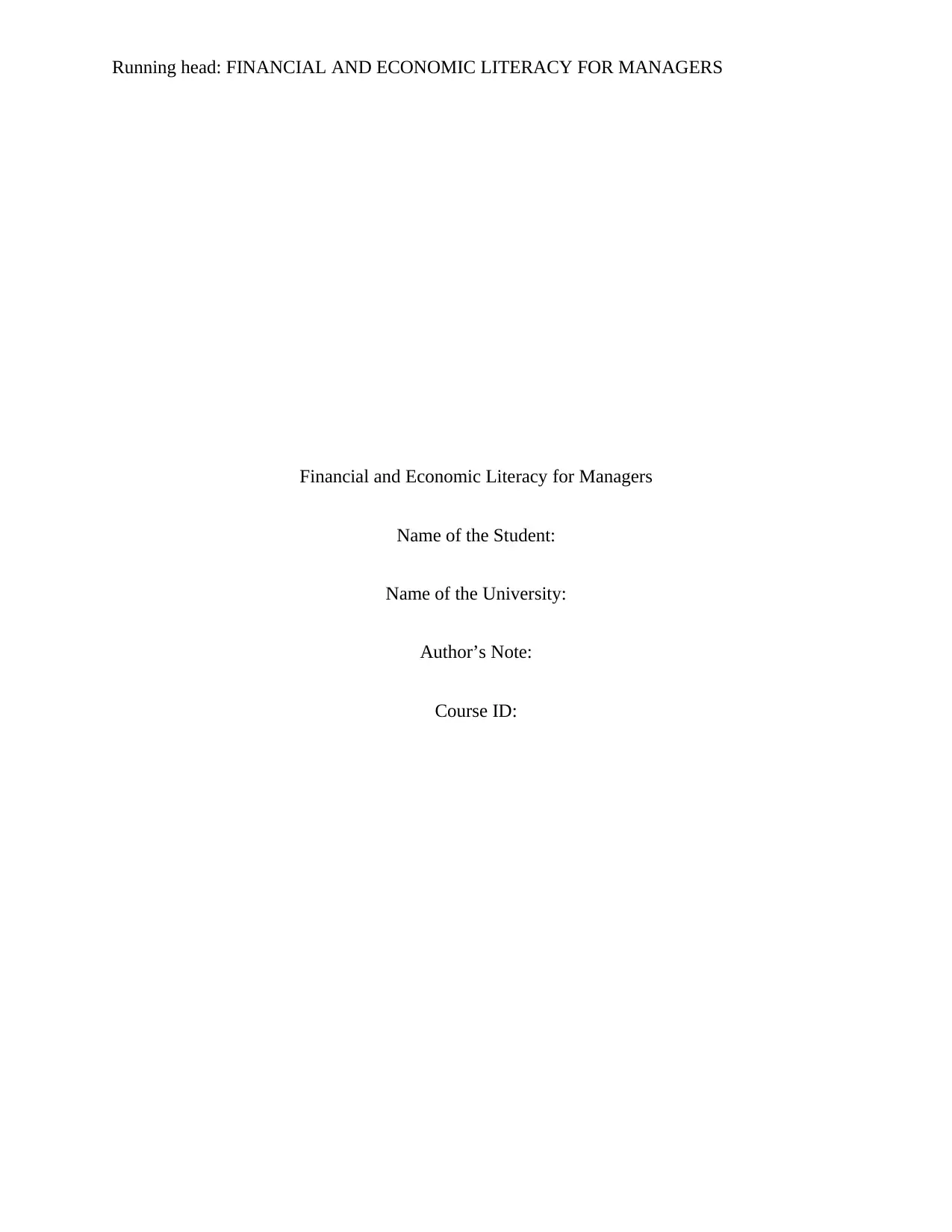
Running head: FINANCIAL AND ECONOMIC LITERACY FOR MANAGERS
Financial and Economic Literacy for Managers
Name of the Student:
Name of the University:
Author’s Note:
Course ID:
Financial and Economic Literacy for Managers
Name of the Student:
Name of the University:
Author’s Note:
Course ID:
Paraphrase This Document
Need a fresh take? Get an instant paraphrase of this document with our AI Paraphraser

1FINANCIAL AND ECONOMIC LITERACY FOR MANAGERS
Table of Contents
Answer to Question 1:.....................................................................................................................2
Answer to question 2:......................................................................................................................4
Answer to question 3:......................................................................................................................6
Answer to Question 4:.....................................................................................................................8
Answer to Question 5:...................................................................................................................12
Part a:.........................................................................................................................................12
Part b:.........................................................................................................................................15
Part c:.........................................................................................................................................15
References:....................................................................................................................................16
Appendices:...................................................................................................................................18
Table of Contents
Answer to Question 1:.....................................................................................................................2
Answer to question 2:......................................................................................................................4
Answer to question 3:......................................................................................................................6
Answer to Question 4:.....................................................................................................................8
Answer to Question 5:...................................................................................................................12
Part a:.........................................................................................................................................12
Part b:.........................................................................................................................................15
Part c:.........................................................................................................................................15
References:....................................................................................................................................16
Appendices:...................................................................................................................................18
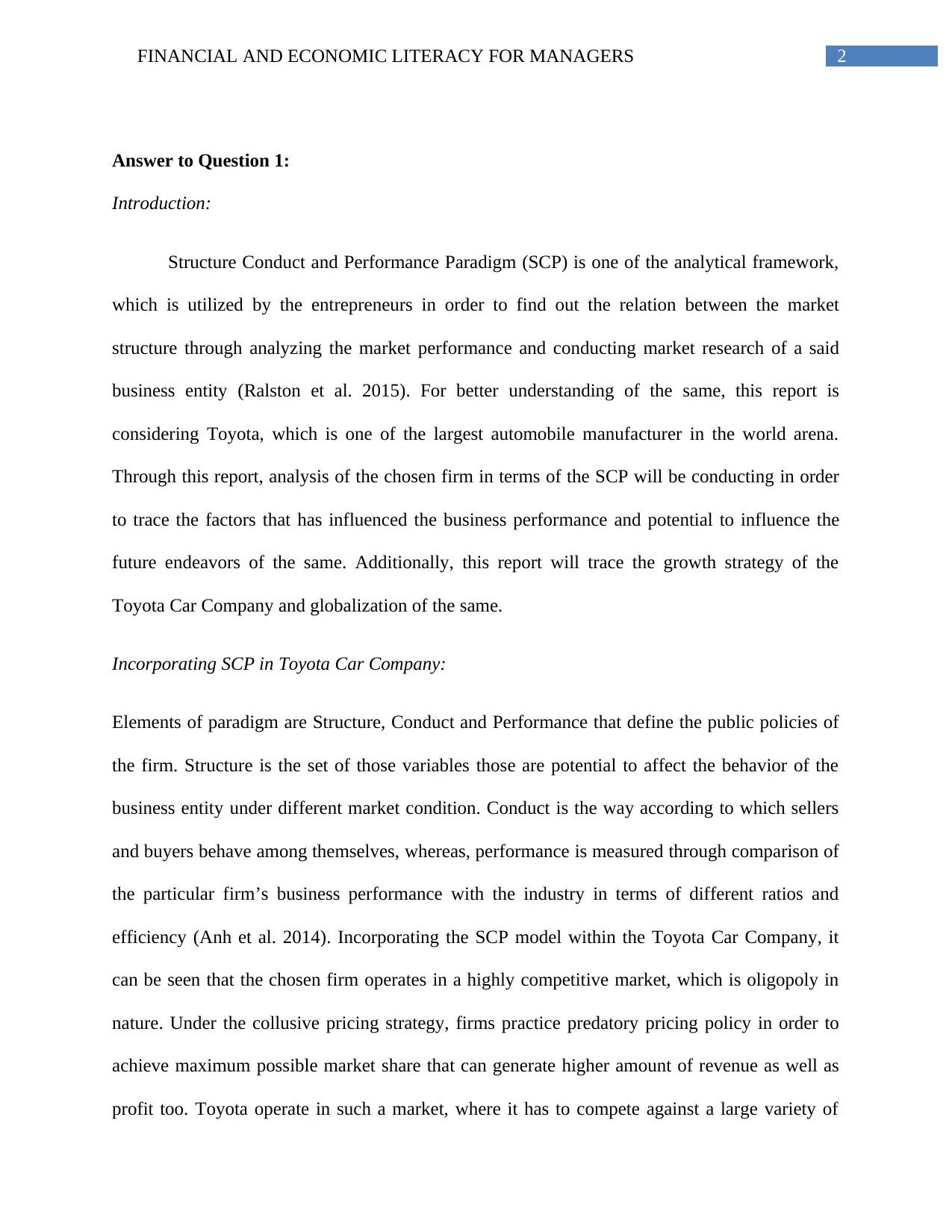
2FINANCIAL AND ECONOMIC LITERACY FOR MANAGERS
Answer to Question 1:
Introduction:
Structure Conduct and Performance Paradigm (SCP) is one of the analytical framework,
which is utilized by the entrepreneurs in order to find out the relation between the market
structure through analyzing the market performance and conducting market research of a said
business entity (Ralston et al. 2015). For better understanding of the same, this report is
considering Toyota, which is one of the largest automobile manufacturer in the world arena.
Through this report, analysis of the chosen firm in terms of the SCP will be conducting in order
to trace the factors that has influenced the business performance and potential to influence the
future endeavors of the same. Additionally, this report will trace the growth strategy of the
Toyota Car Company and globalization of the same.
Incorporating SCP in Toyota Car Company:
Elements of paradigm are Structure, Conduct and Performance that define the public policies of
the firm. Structure is the set of those variables those are potential to affect the behavior of the
business entity under different market condition. Conduct is the way according to which sellers
and buyers behave among themselves, whereas, performance is measured through comparison of
the particular firm’s business performance with the industry in terms of different ratios and
efficiency (Anh et al. 2014). Incorporating the SCP model within the Toyota Car Company, it
can be seen that the chosen firm operates in a highly competitive market, which is oligopoly in
nature. Under the collusive pricing strategy, firms practice predatory pricing policy in order to
achieve maximum possible market share that can generate higher amount of revenue as well as
profit too. Toyota operate in such a market, where it has to compete against a large variety of
Answer to Question 1:
Introduction:
Structure Conduct and Performance Paradigm (SCP) is one of the analytical framework,
which is utilized by the entrepreneurs in order to find out the relation between the market
structure through analyzing the market performance and conducting market research of a said
business entity (Ralston et al. 2015). For better understanding of the same, this report is
considering Toyota, which is one of the largest automobile manufacturer in the world arena.
Through this report, analysis of the chosen firm in terms of the SCP will be conducting in order
to trace the factors that has influenced the business performance and potential to influence the
future endeavors of the same. Additionally, this report will trace the growth strategy of the
Toyota Car Company and globalization of the same.
Incorporating SCP in Toyota Car Company:
Elements of paradigm are Structure, Conduct and Performance that define the public policies of
the firm. Structure is the set of those variables those are potential to affect the behavior of the
business entity under different market condition. Conduct is the way according to which sellers
and buyers behave among themselves, whereas, performance is measured through comparison of
the particular firm’s business performance with the industry in terms of different ratios and
efficiency (Anh et al. 2014). Incorporating the SCP model within the Toyota Car Company, it
can be seen that the chosen firm operates in a highly competitive market, which is oligopoly in
nature. Under the collusive pricing strategy, firms practice predatory pricing policy in order to
achieve maximum possible market share that can generate higher amount of revenue as well as
profit too. Toyota operate in such a market, where it has to compete against a large variety of
⊘ This is a preview!⊘
Do you want full access?
Subscribe today to unlock all pages.

Trusted by 1+ million students worldwide
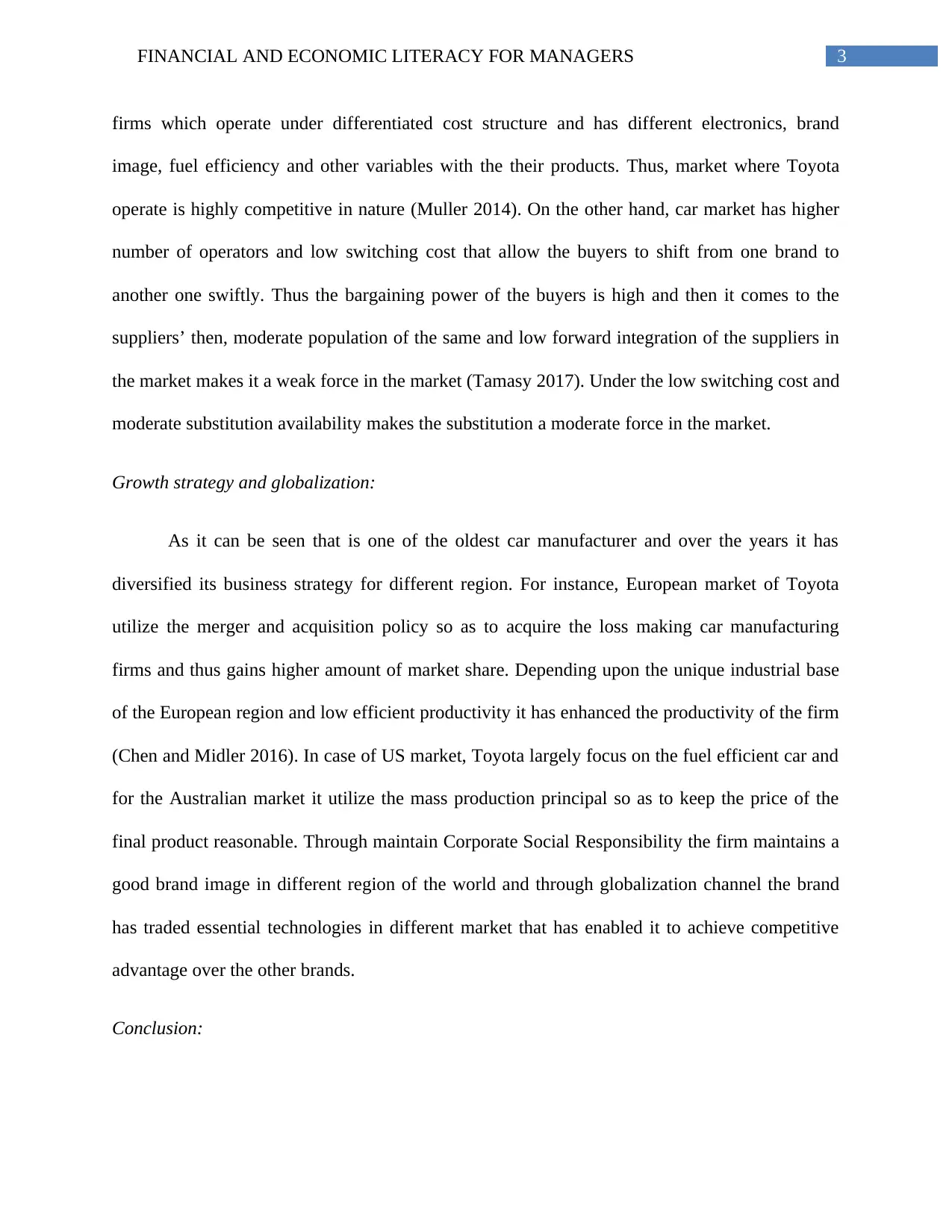
3FINANCIAL AND ECONOMIC LITERACY FOR MANAGERS
firms which operate under differentiated cost structure and has different electronics, brand
image, fuel efficiency and other variables with the their products. Thus, market where Toyota
operate is highly competitive in nature (Muller 2014). On the other hand, car market has higher
number of operators and low switching cost that allow the buyers to shift from one brand to
another one swiftly. Thus the bargaining power of the buyers is high and then it comes to the
suppliers’ then, moderate population of the same and low forward integration of the suppliers in
the market makes it a weak force in the market (Tamasy 2017). Under the low switching cost and
moderate substitution availability makes the substitution a moderate force in the market.
Growth strategy and globalization:
As it can be seen that is one of the oldest car manufacturer and over the years it has
diversified its business strategy for different region. For instance, European market of Toyota
utilize the merger and acquisition policy so as to acquire the loss making car manufacturing
firms and thus gains higher amount of market share. Depending upon the unique industrial base
of the European region and low efficient productivity it has enhanced the productivity of the firm
(Chen and Midler 2016). In case of US market, Toyota largely focus on the fuel efficient car and
for the Australian market it utilize the mass production principal so as to keep the price of the
final product reasonable. Through maintain Corporate Social Responsibility the firm maintains a
good brand image in different region of the world and through globalization channel the brand
has traded essential technologies in different market that has enabled it to achieve competitive
advantage over the other brands.
Conclusion:
firms which operate under differentiated cost structure and has different electronics, brand
image, fuel efficiency and other variables with the their products. Thus, market where Toyota
operate is highly competitive in nature (Muller 2014). On the other hand, car market has higher
number of operators and low switching cost that allow the buyers to shift from one brand to
another one swiftly. Thus the bargaining power of the buyers is high and then it comes to the
suppliers’ then, moderate population of the same and low forward integration of the suppliers in
the market makes it a weak force in the market (Tamasy 2017). Under the low switching cost and
moderate substitution availability makes the substitution a moderate force in the market.
Growth strategy and globalization:
As it can be seen that is one of the oldest car manufacturer and over the years it has
diversified its business strategy for different region. For instance, European market of Toyota
utilize the merger and acquisition policy so as to acquire the loss making car manufacturing
firms and thus gains higher amount of market share. Depending upon the unique industrial base
of the European region and low efficient productivity it has enhanced the productivity of the firm
(Chen and Midler 2016). In case of US market, Toyota largely focus on the fuel efficient car and
for the Australian market it utilize the mass production principal so as to keep the price of the
final product reasonable. Through maintain Corporate Social Responsibility the firm maintains a
good brand image in different region of the world and through globalization channel the brand
has traded essential technologies in different market that has enabled it to achieve competitive
advantage over the other brands.
Conclusion:
Paraphrase This Document
Need a fresh take? Get an instant paraphrase of this document with our AI Paraphraser
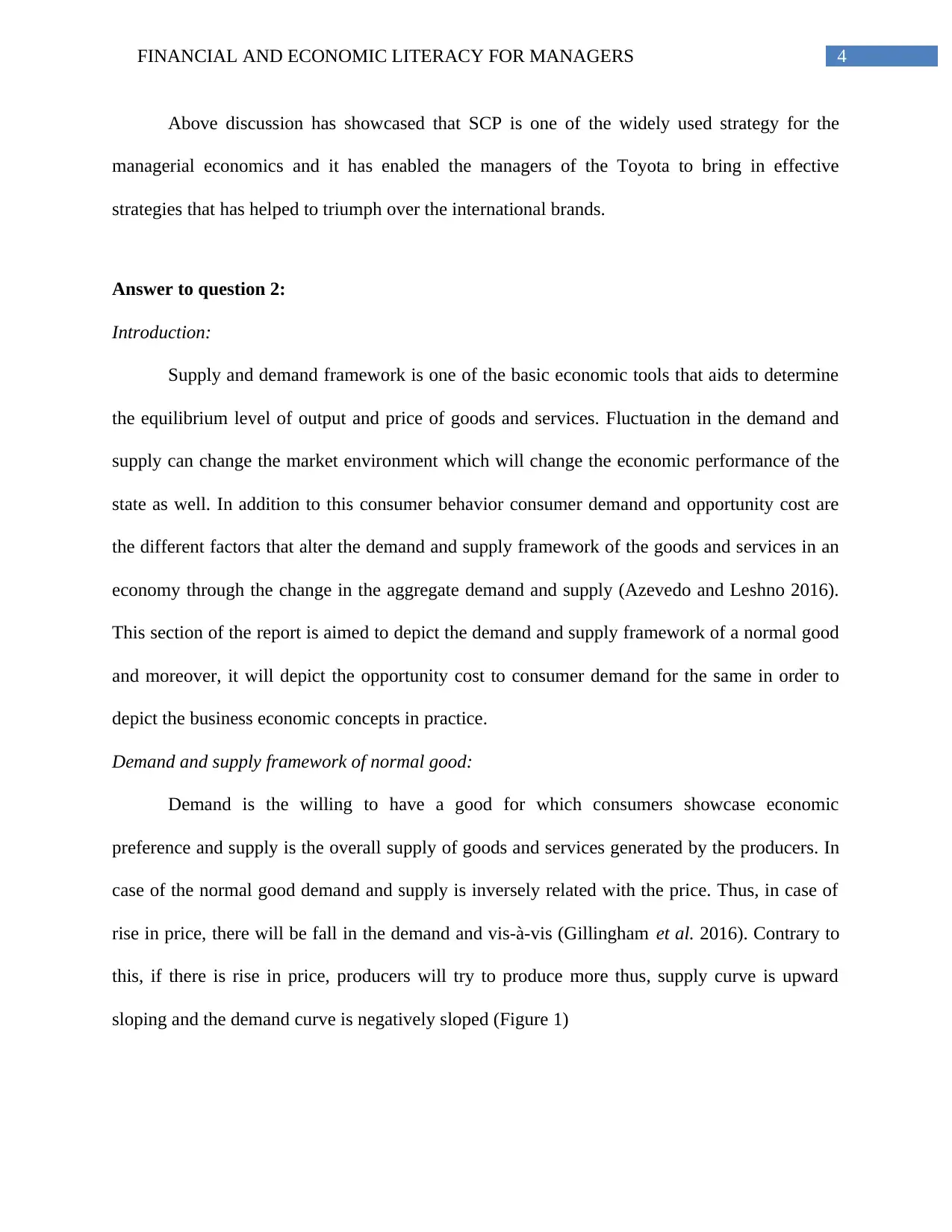
4FINANCIAL AND ECONOMIC LITERACY FOR MANAGERS
Above discussion has showcased that SCP is one of the widely used strategy for the
managerial economics and it has enabled the managers of the Toyota to bring in effective
strategies that has helped to triumph over the international brands.
Answer to question 2:
Introduction:
Supply and demand framework is one of the basic economic tools that aids to determine
the equilibrium level of output and price of goods and services. Fluctuation in the demand and
supply can change the market environment which will change the economic performance of the
state as well. In addition to this consumer behavior consumer demand and opportunity cost are
the different factors that alter the demand and supply framework of the goods and services in an
economy through the change in the aggregate demand and supply (Azevedo and Leshno 2016).
This section of the report is aimed to depict the demand and supply framework of a normal good
and moreover, it will depict the opportunity cost to consumer demand for the same in order to
depict the business economic concepts in practice.
Demand and supply framework of normal good:
Demand is the willing to have a good for which consumers showcase economic
preference and supply is the overall supply of goods and services generated by the producers. In
case of the normal good demand and supply is inversely related with the price. Thus, in case of
rise in price, there will be fall in the demand and vis-à-vis (Gillingham et al. 2016). Contrary to
this, if there is rise in price, producers will try to produce more thus, supply curve is upward
sloping and the demand curve is negatively sloped (Figure 1)
Above discussion has showcased that SCP is one of the widely used strategy for the
managerial economics and it has enabled the managers of the Toyota to bring in effective
strategies that has helped to triumph over the international brands.
Answer to question 2:
Introduction:
Supply and demand framework is one of the basic economic tools that aids to determine
the equilibrium level of output and price of goods and services. Fluctuation in the demand and
supply can change the market environment which will change the economic performance of the
state as well. In addition to this consumer behavior consumer demand and opportunity cost are
the different factors that alter the demand and supply framework of the goods and services in an
economy through the change in the aggregate demand and supply (Azevedo and Leshno 2016).
This section of the report is aimed to depict the demand and supply framework of a normal good
and moreover, it will depict the opportunity cost to consumer demand for the same in order to
depict the business economic concepts in practice.
Demand and supply framework of normal good:
Demand is the willing to have a good for which consumers showcase economic
preference and supply is the overall supply of goods and services generated by the producers. In
case of the normal good demand and supply is inversely related with the price. Thus, in case of
rise in price, there will be fall in the demand and vis-à-vis (Gillingham et al. 2016). Contrary to
this, if there is rise in price, producers will try to produce more thus, supply curve is upward
sloping and the demand curve is negatively sloped (Figure 1)
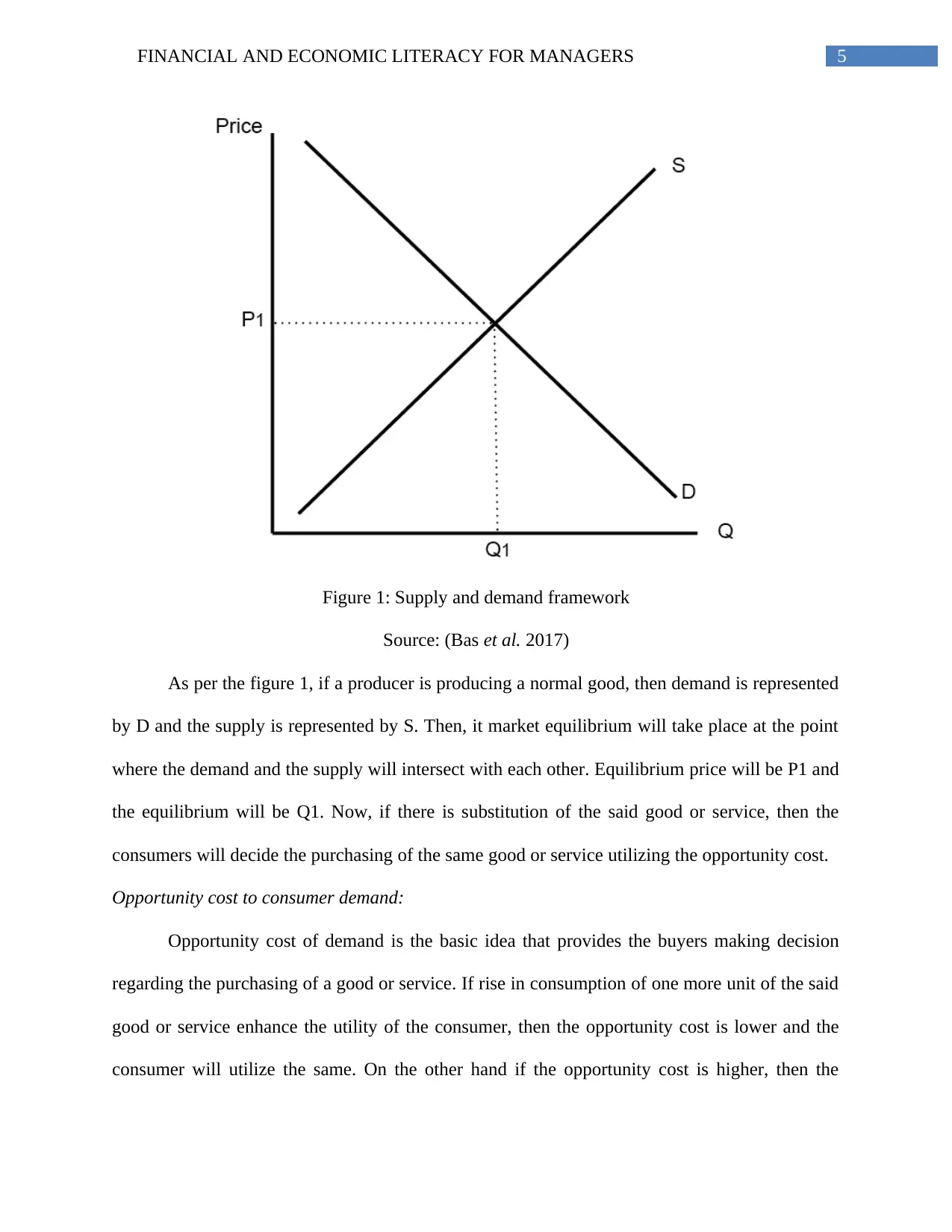
5FINANCIAL AND ECONOMIC LITERACY FOR MANAGERS
Figure 1: Supply and demand framework
Source: (Bas et al. 2017)
As per the figure 1, if a producer is producing a normal good, then demand is represented
by D and the supply is represented by S. Then, it market equilibrium will take place at the point
where the demand and the supply will intersect with each other. Equilibrium price will be P1 and
the equilibrium will be Q1. Now, if there is substitution of the said good or service, then the
consumers will decide the purchasing of the same good or service utilizing the opportunity cost.
Opportunity cost to consumer demand:
Opportunity cost of demand is the basic idea that provides the buyers making decision
regarding the purchasing of a good or service. If rise in consumption of one more unit of the said
good or service enhance the utility of the consumer, then the opportunity cost is lower and the
consumer will utilize the same. On the other hand if the opportunity cost is higher, then the
Figure 1: Supply and demand framework
Source: (Bas et al. 2017)
As per the figure 1, if a producer is producing a normal good, then demand is represented
by D and the supply is represented by S. Then, it market equilibrium will take place at the point
where the demand and the supply will intersect with each other. Equilibrium price will be P1 and
the equilibrium will be Q1. Now, if there is substitution of the said good or service, then the
consumers will decide the purchasing of the same good or service utilizing the opportunity cost.
Opportunity cost to consumer demand:
Opportunity cost of demand is the basic idea that provides the buyers making decision
regarding the purchasing of a good or service. If rise in consumption of one more unit of the said
good or service enhance the utility of the consumer, then the opportunity cost is lower and the
consumer will utilize the same. On the other hand if the opportunity cost is higher, then the
⊘ This is a preview!⊘
Do you want full access?
Subscribe today to unlock all pages.

Trusted by 1+ million students worldwide
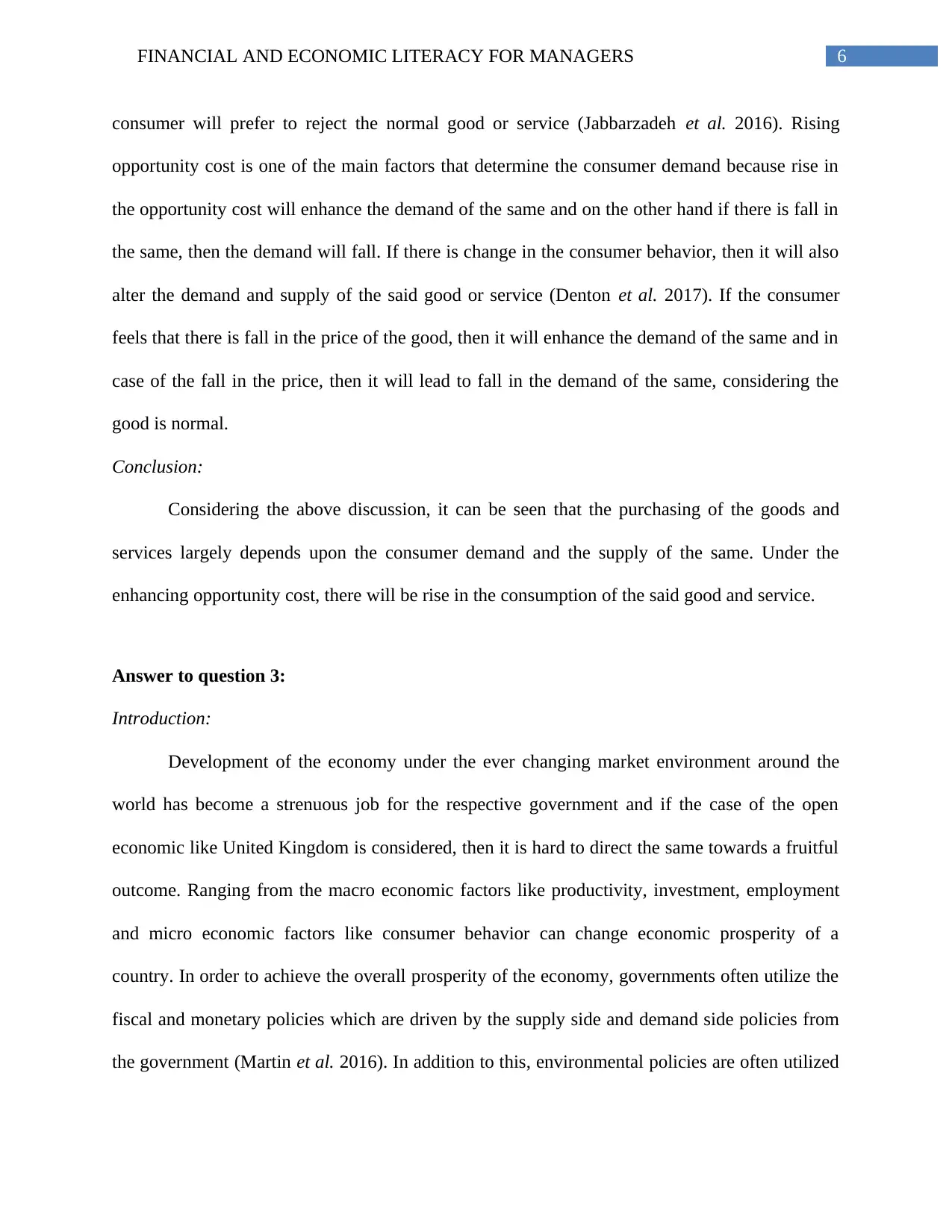
6FINANCIAL AND ECONOMIC LITERACY FOR MANAGERS
consumer will prefer to reject the normal good or service (Jabbarzadeh et al. 2016). Rising
opportunity cost is one of the main factors that determine the consumer demand because rise in
the opportunity cost will enhance the demand of the same and on the other hand if there is fall in
the same, then the demand will fall. If there is change in the consumer behavior, then it will also
alter the demand and supply of the said good or service (Denton et al. 2017). If the consumer
feels that there is fall in the price of the good, then it will enhance the demand of the same and in
case of the fall in the price, then it will lead to fall in the demand of the same, considering the
good is normal.
Conclusion:
Considering the above discussion, it can be seen that the purchasing of the goods and
services largely depends upon the consumer demand and the supply of the same. Under the
enhancing opportunity cost, there will be rise in the consumption of the said good and service.
Answer to question 3:
Introduction:
Development of the economy under the ever changing market environment around the
world has become a strenuous job for the respective government and if the case of the open
economic like United Kingdom is considered, then it is hard to direct the same towards a fruitful
outcome. Ranging from the macro economic factors like productivity, investment, employment
and micro economic factors like consumer behavior can change economic prosperity of a
country. In order to achieve the overall prosperity of the economy, governments often utilize the
fiscal and monetary policies which are driven by the supply side and demand side policies from
the government (Martin et al. 2016). In addition to this, environmental policies are often utilized
consumer will prefer to reject the normal good or service (Jabbarzadeh et al. 2016). Rising
opportunity cost is one of the main factors that determine the consumer demand because rise in
the opportunity cost will enhance the demand of the same and on the other hand if there is fall in
the same, then the demand will fall. If there is change in the consumer behavior, then it will also
alter the demand and supply of the said good or service (Denton et al. 2017). If the consumer
feels that there is fall in the price of the good, then it will enhance the demand of the same and in
case of the fall in the price, then it will lead to fall in the demand of the same, considering the
good is normal.
Conclusion:
Considering the above discussion, it can be seen that the purchasing of the goods and
services largely depends upon the consumer demand and the supply of the same. Under the
enhancing opportunity cost, there will be rise in the consumption of the said good and service.
Answer to question 3:
Introduction:
Development of the economy under the ever changing market environment around the
world has become a strenuous job for the respective government and if the case of the open
economic like United Kingdom is considered, then it is hard to direct the same towards a fruitful
outcome. Ranging from the macro economic factors like productivity, investment, employment
and micro economic factors like consumer behavior can change economic prosperity of a
country. In order to achieve the overall prosperity of the economy, governments often utilize the
fiscal and monetary policies which are driven by the supply side and demand side policies from
the government (Martin et al. 2016). In addition to this, environmental policies are often utilized
Paraphrase This Document
Need a fresh take? Get an instant paraphrase of this document with our AI Paraphraser
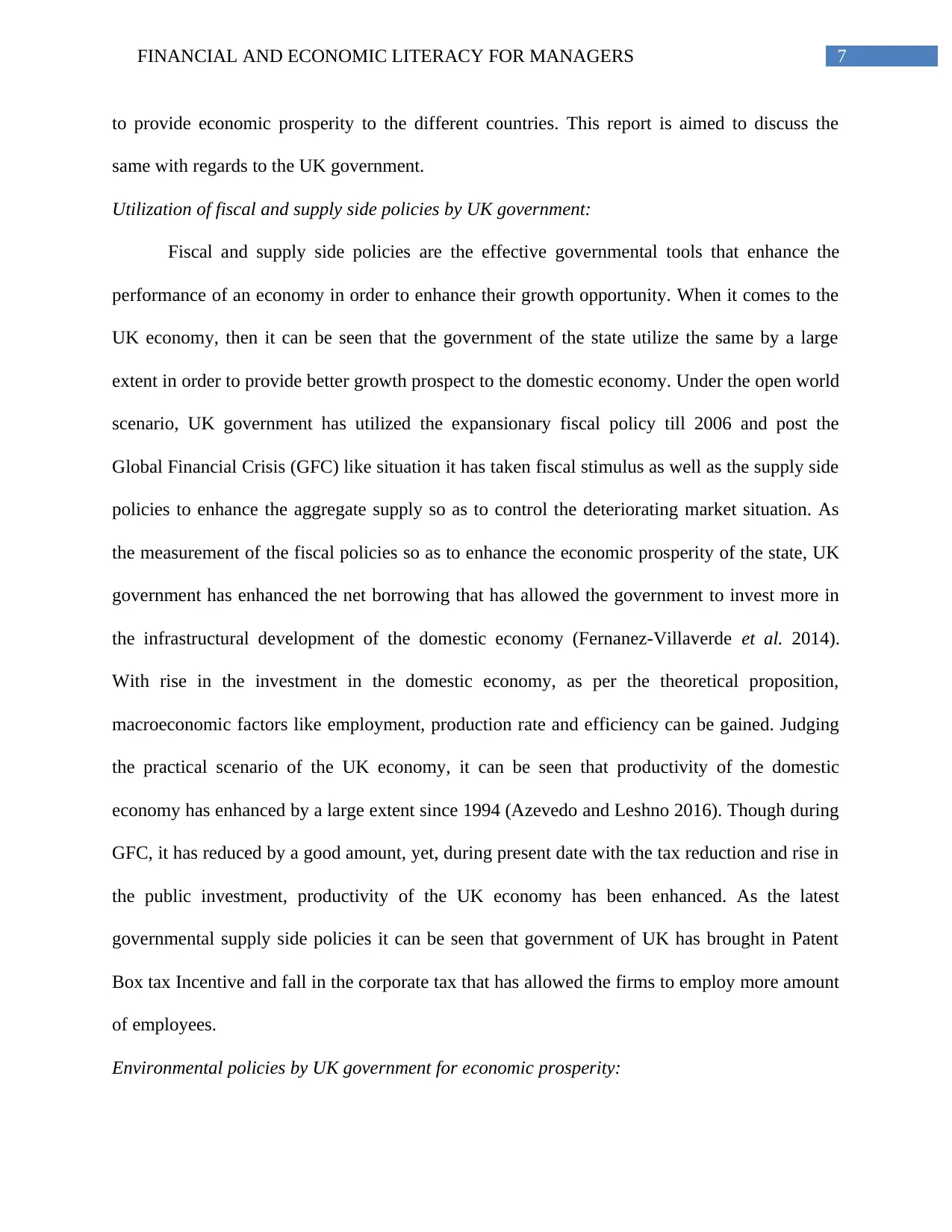
7FINANCIAL AND ECONOMIC LITERACY FOR MANAGERS
to provide economic prosperity to the different countries. This report is aimed to discuss the
same with regards to the UK government.
Utilization of fiscal and supply side policies by UK government:
Fiscal and supply side policies are the effective governmental tools that enhance the
performance of an economy in order to enhance their growth opportunity. When it comes to the
UK economy, then it can be seen that the government of the state utilize the same by a large
extent in order to provide better growth prospect to the domestic economy. Under the open world
scenario, UK government has utilized the expansionary fiscal policy till 2006 and post the
Global Financial Crisis (GFC) like situation it has taken fiscal stimulus as well as the supply side
policies to enhance the aggregate supply so as to control the deteriorating market situation. As
the measurement of the fiscal policies so as to enhance the economic prosperity of the state, UK
government has enhanced the net borrowing that has allowed the government to invest more in
the infrastructural development of the domestic economy (Fernanez-Villaverde et al. 2014).
With rise in the investment in the domestic economy, as per the theoretical proposition,
macroeconomic factors like employment, production rate and efficiency can be gained. Judging
the practical scenario of the UK economy, it can be seen that productivity of the domestic
economy has enhanced by a large extent since 1994 (Azevedo and Leshno 2016). Though during
GFC, it has reduced by a good amount, yet, during present date with the tax reduction and rise in
the public investment, productivity of the UK economy has been enhanced. As the latest
governmental supply side policies it can be seen that government of UK has brought in Patent
Box tax Incentive and fall in the corporate tax that has allowed the firms to employ more amount
of employees.
Environmental policies by UK government for economic prosperity:
to provide economic prosperity to the different countries. This report is aimed to discuss the
same with regards to the UK government.
Utilization of fiscal and supply side policies by UK government:
Fiscal and supply side policies are the effective governmental tools that enhance the
performance of an economy in order to enhance their growth opportunity. When it comes to the
UK economy, then it can be seen that the government of the state utilize the same by a large
extent in order to provide better growth prospect to the domestic economy. Under the open world
scenario, UK government has utilized the expansionary fiscal policy till 2006 and post the
Global Financial Crisis (GFC) like situation it has taken fiscal stimulus as well as the supply side
policies to enhance the aggregate supply so as to control the deteriorating market situation. As
the measurement of the fiscal policies so as to enhance the economic prosperity of the state, UK
government has enhanced the net borrowing that has allowed the government to invest more in
the infrastructural development of the domestic economy (Fernanez-Villaverde et al. 2014).
With rise in the investment in the domestic economy, as per the theoretical proposition,
macroeconomic factors like employment, production rate and efficiency can be gained. Judging
the practical scenario of the UK economy, it can be seen that productivity of the domestic
economy has enhanced by a large extent since 1994 (Azevedo and Leshno 2016). Though during
GFC, it has reduced by a good amount, yet, during present date with the tax reduction and rise in
the public investment, productivity of the UK economy has been enhanced. As the latest
governmental supply side policies it can be seen that government of UK has brought in Patent
Box tax Incentive and fall in the corporate tax that has allowed the firms to employ more amount
of employees.
Environmental policies by UK government for economic prosperity:
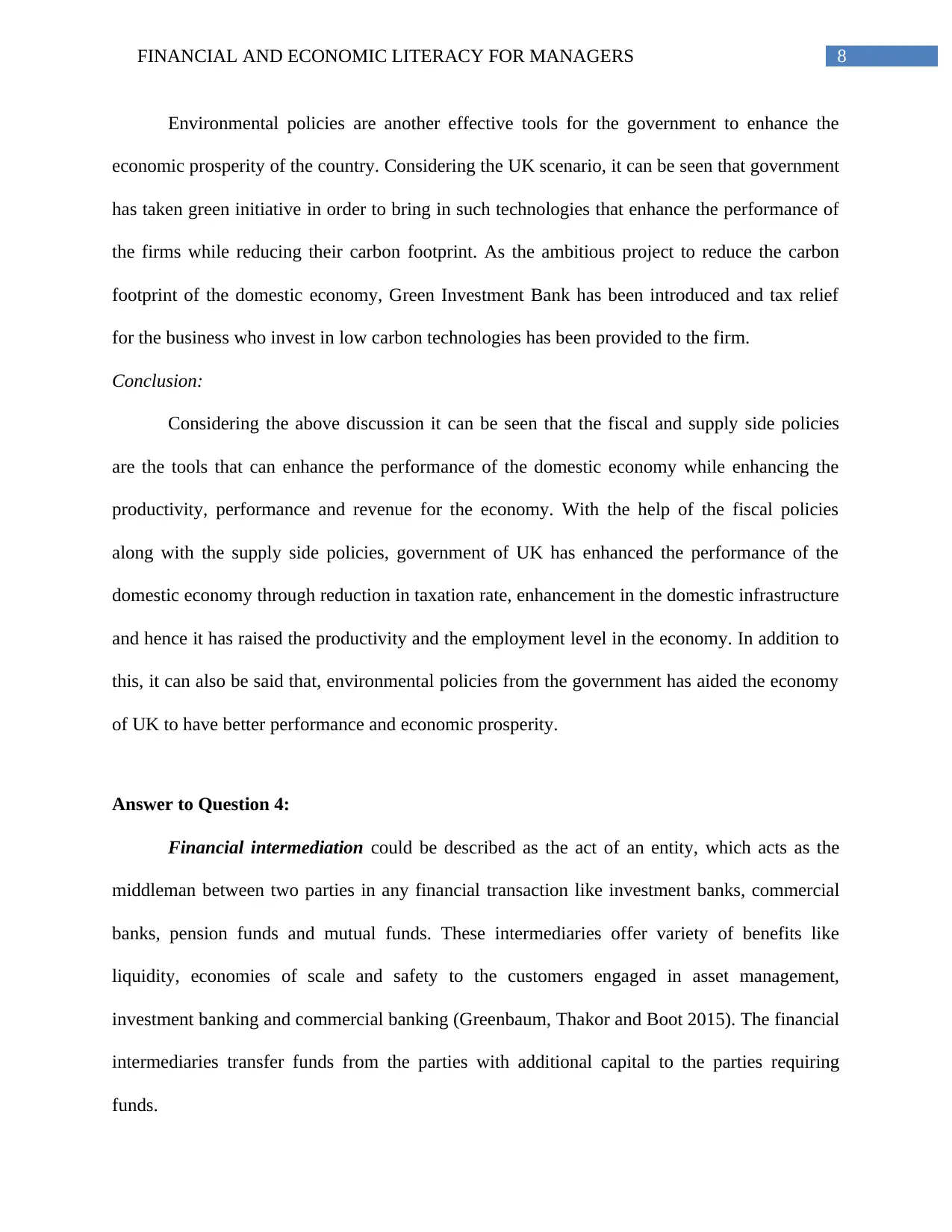
8FINANCIAL AND ECONOMIC LITERACY FOR MANAGERS
Environmental policies are another effective tools for the government to enhance the
economic prosperity of the country. Considering the UK scenario, it can be seen that government
has taken green initiative in order to bring in such technologies that enhance the performance of
the firms while reducing their carbon footprint. As the ambitious project to reduce the carbon
footprint of the domestic economy, Green Investment Bank has been introduced and tax relief
for the business who invest in low carbon technologies has been provided to the firm.
Conclusion:
Considering the above discussion it can be seen that the fiscal and supply side policies
are the tools that can enhance the performance of the domestic economy while enhancing the
productivity, performance and revenue for the economy. With the help of the fiscal policies
along with the supply side policies, government of UK has enhanced the performance of the
domestic economy through reduction in taxation rate, enhancement in the domestic infrastructure
and hence it has raised the productivity and the employment level in the economy. In addition to
this, it can also be said that, environmental policies from the government has aided the economy
of UK to have better performance and economic prosperity.
Answer to Question 4:
Financial intermediation could be described as the act of an entity, which acts as the
middleman between two parties in any financial transaction like investment banks, commercial
banks, pension funds and mutual funds. These intermediaries offer variety of benefits like
liquidity, economies of scale and safety to the customers engaged in asset management,
investment banking and commercial banking (Greenbaum, Thakor and Boot 2015). The financial
intermediaries transfer funds from the parties with additional capital to the parties requiring
funds.
Environmental policies are another effective tools for the government to enhance the
economic prosperity of the country. Considering the UK scenario, it can be seen that government
has taken green initiative in order to bring in such technologies that enhance the performance of
the firms while reducing their carbon footprint. As the ambitious project to reduce the carbon
footprint of the domestic economy, Green Investment Bank has been introduced and tax relief
for the business who invest in low carbon technologies has been provided to the firm.
Conclusion:
Considering the above discussion it can be seen that the fiscal and supply side policies
are the tools that can enhance the performance of the domestic economy while enhancing the
productivity, performance and revenue for the economy. With the help of the fiscal policies
along with the supply side policies, government of UK has enhanced the performance of the
domestic economy through reduction in taxation rate, enhancement in the domestic infrastructure
and hence it has raised the productivity and the employment level in the economy. In addition to
this, it can also be said that, environmental policies from the government has aided the economy
of UK to have better performance and economic prosperity.
Answer to Question 4:
Financial intermediation could be described as the act of an entity, which acts as the
middleman between two parties in any financial transaction like investment banks, commercial
banks, pension funds and mutual funds. These intermediaries offer variety of benefits like
liquidity, economies of scale and safety to the customers engaged in asset management,
investment banking and commercial banking (Greenbaum, Thakor and Boot 2015). The financial
intermediaries transfer funds from the parties with additional capital to the parties requiring
funds.
⊘ This is a preview!⊘
Do you want full access?
Subscribe today to unlock all pages.

Trusted by 1+ million students worldwide
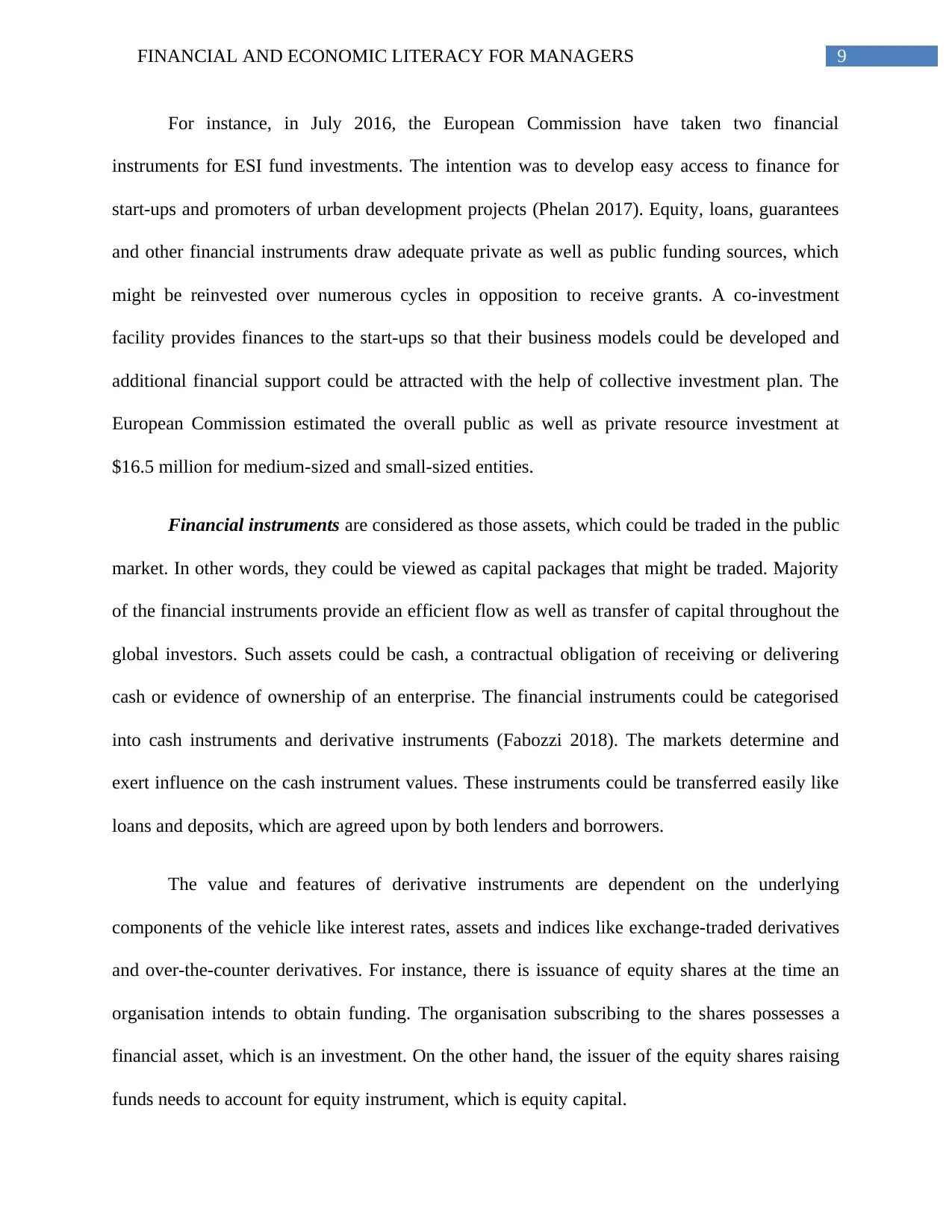
9FINANCIAL AND ECONOMIC LITERACY FOR MANAGERS
For instance, in July 2016, the European Commission have taken two financial
instruments for ESI fund investments. The intention was to develop easy access to finance for
start-ups and promoters of urban development projects (Phelan 2017). Equity, loans, guarantees
and other financial instruments draw adequate private as well as public funding sources, which
might be reinvested over numerous cycles in opposition to receive grants. A co-investment
facility provides finances to the start-ups so that their business models could be developed and
additional financial support could be attracted with the help of collective investment plan. The
European Commission estimated the overall public as well as private resource investment at
$16.5 million for medium-sized and small-sized entities.
Financial instruments are considered as those assets, which could be traded in the public
market. In other words, they could be viewed as capital packages that might be traded. Majority
of the financial instruments provide an efficient flow as well as transfer of capital throughout the
global investors. Such assets could be cash, a contractual obligation of receiving or delivering
cash or evidence of ownership of an enterprise. The financial instruments could be categorised
into cash instruments and derivative instruments (Fabozzi 2018). The markets determine and
exert influence on the cash instrument values. These instruments could be transferred easily like
loans and deposits, which are agreed upon by both lenders and borrowers.
The value and features of derivative instruments are dependent on the underlying
components of the vehicle like interest rates, assets and indices like exchange-traded derivatives
and over-the-counter derivatives. For instance, there is issuance of equity shares at the time an
organisation intends to obtain funding. The organisation subscribing to the shares possesses a
financial asset, which is an investment. On the other hand, the issuer of the equity shares raising
funds needs to account for equity instrument, which is equity capital.
For instance, in July 2016, the European Commission have taken two financial
instruments for ESI fund investments. The intention was to develop easy access to finance for
start-ups and promoters of urban development projects (Phelan 2017). Equity, loans, guarantees
and other financial instruments draw adequate private as well as public funding sources, which
might be reinvested over numerous cycles in opposition to receive grants. A co-investment
facility provides finances to the start-ups so that their business models could be developed and
additional financial support could be attracted with the help of collective investment plan. The
European Commission estimated the overall public as well as private resource investment at
$16.5 million for medium-sized and small-sized entities.
Financial instruments are considered as those assets, which could be traded in the public
market. In other words, they could be viewed as capital packages that might be traded. Majority
of the financial instruments provide an efficient flow as well as transfer of capital throughout the
global investors. Such assets could be cash, a contractual obligation of receiving or delivering
cash or evidence of ownership of an enterprise. The financial instruments could be categorised
into cash instruments and derivative instruments (Fabozzi 2018). The markets determine and
exert influence on the cash instrument values. These instruments could be transferred easily like
loans and deposits, which are agreed upon by both lenders and borrowers.
The value and features of derivative instruments are dependent on the underlying
components of the vehicle like interest rates, assets and indices like exchange-traded derivatives
and over-the-counter derivatives. For instance, there is issuance of equity shares at the time an
organisation intends to obtain funding. The organisation subscribing to the shares possesses a
financial asset, which is an investment. On the other hand, the issuer of the equity shares raising
funds needs to account for equity instrument, which is equity capital.
Paraphrase This Document
Need a fresh take? Get an instant paraphrase of this document with our AI Paraphraser
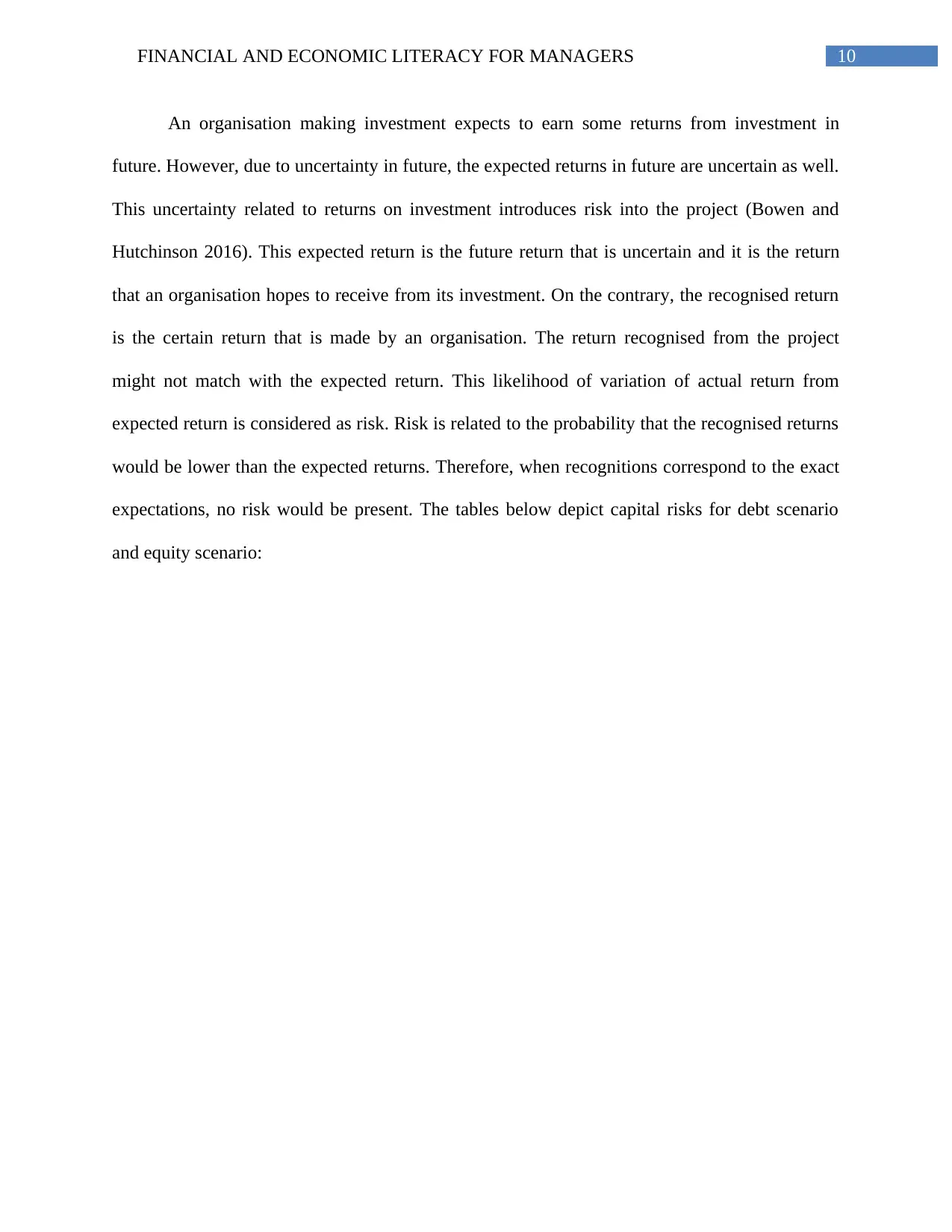
10FINANCIAL AND ECONOMIC LITERACY FOR MANAGERS
An organisation making investment expects to earn some returns from investment in
future. However, due to uncertainty in future, the expected returns in future are uncertain as well.
This uncertainty related to returns on investment introduces risk into the project (Bowen and
Hutchinson 2016). This expected return is the future return that is uncertain and it is the return
that an organisation hopes to receive from its investment. On the contrary, the recognised return
is the certain return that is made by an organisation. The return recognised from the project
might not match with the expected return. This likelihood of variation of actual return from
expected return is considered as risk. Risk is related to the probability that the recognised returns
would be lower than the expected returns. Therefore, when recognitions correspond to the exact
expectations, no risk would be present. The tables below depict capital risks for debt scenario
and equity scenario:
An organisation making investment expects to earn some returns from investment in
future. However, due to uncertainty in future, the expected returns in future are uncertain as well.
This uncertainty related to returns on investment introduces risk into the project (Bowen and
Hutchinson 2016). This expected return is the future return that is uncertain and it is the return
that an organisation hopes to receive from its investment. On the contrary, the recognised return
is the certain return that is made by an organisation. The return recognised from the project
might not match with the expected return. This likelihood of variation of actual return from
expected return is considered as risk. Risk is related to the probability that the recognised returns
would be lower than the expected returns. Therefore, when recognitions correspond to the exact
expectations, no risk would be present. The tables below depict capital risks for debt scenario
and equity scenario:
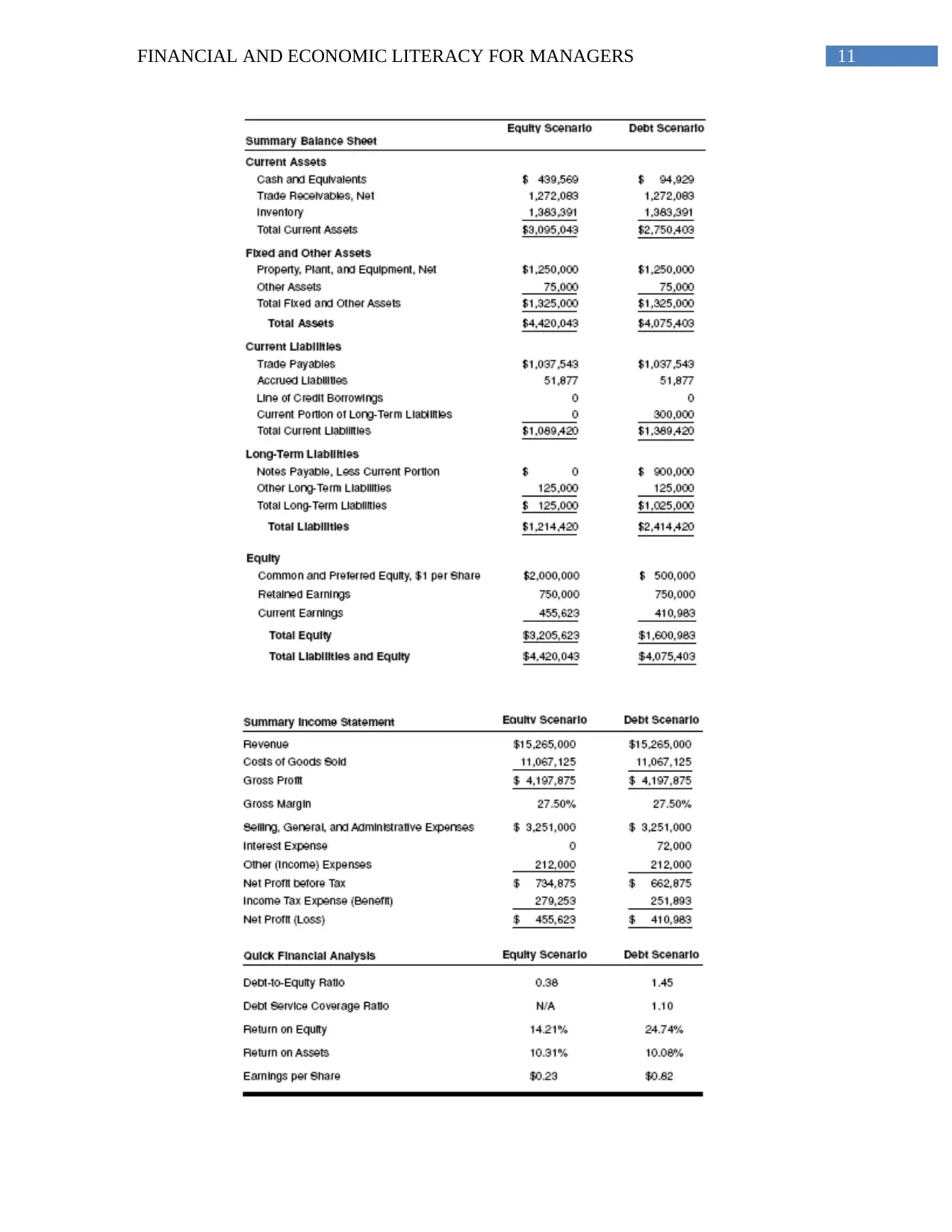
11FINANCIAL AND ECONOMIC LITERACY FOR MANAGERS
⊘ This is a preview!⊘
Do you want full access?
Subscribe today to unlock all pages.

Trusted by 1+ million students worldwide
1 out of 20
Related Documents
Your All-in-One AI-Powered Toolkit for Academic Success.
+13062052269
info@desklib.com
Available 24*7 on WhatsApp / Email
![[object Object]](/_next/static/media/star-bottom.7253800d.svg)
Unlock your academic potential
Copyright © 2020–2025 A2Z Services. All Rights Reserved. Developed and managed by ZUCOL.





